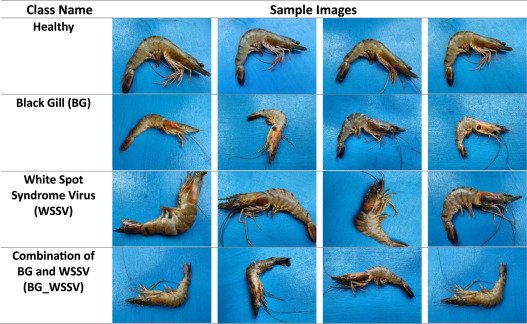
Shrimp farming is a fundamental economic pillar for Bangladesh, supporting millions of people in coastal areas. However, this vital sector faces the constant threat of prevalent shrimp diseases such as White Spot Syndrome Virus (WSSV) and Black Gill (BG) disease, which can devastate production, impact the economy, and harm the environment. Early and accurate detection is crucial, but traditional manual inspection methods are often slow and error-prone.
To address this critical need, a team of researchers from East West University has developed Shrimp DiseaseBD, a public image dataset specifically designed to facilitate the development of automated shrimp disease detection systems using computer vision and artificial intelligence.
The Challenge: Devastating Diseases and Manual Detection
The two most common diseases addressed in this project are:
- Black Gill (BG): Caused by fungi, bacteria, or environmental factors, it causes darkening of the gills, weakening the shrimp and making it more susceptible to other infections.
- White Spot Syndrome Virus (WSSV): Characterized by visible white spots on the carapace and sometimes a reddish discoloration, this viral disease is highly contagious, causes high mortality, and affects shrimp farming worldwide.
Currently, detection in Bangladesh relies mainly on visual inspection by farmers. Failure to detect and remove sick shrimp in time can trigger massive outbreaks, resulting in significant economic losses. Furthermore, the common response with broad-spectrum antibiotic treatments raises concerns about their negative environmental impact.
The Technological Solution: The Shrimp DiseaseBD Dataset
Shrimp DiseaseBD emerges as a fundamental tool to overcome these limitations. It is a comprehensive collection of shrimp images created to train and validate machine learning models.
Key Dataset Features:
- Content: 1149 original images in JPG format, with a resolution of 2048×2048 pixels.
- Origin: The images were captured using high-quality smartphone cameras on local shrimp farms (mainly in Bagerhat and Satkhira) and markets (Dhaka), under the supervision of experts from the Bangladesh Fisheries Research Institute (BAFRI) and local farmers.
- Classification: The images are organized into four clear categories:
- Healthy: 403 images of shrimp with no visible signs of disease, showing normal coloration and shape.
- Black Gill (BG): 198 images of shrimp with darkened gills.
- White Spot (WSSV): 328 images of shrimp showing the characteristic white spots.
- Combination (BG_WSSV): 220 images of shrimp exhibiting symptoms of both diseases simultaneously.
- Annotation for AI: A crucial aspect is that the images of diseased shrimp have been carefully annotated using the Roboflow tool. Specific areas showing disease symptoms have been marked using bounding boxes in YOLO format. This annotation is essential for training AI models capable of accurately detecting and locating diseases.
- Organized Structure: The dataset is logically structured into folders (“Raw Images” and “Annotated Diseased Shrimp Images”), facilitating integration with popular Machine Learning frameworks.
Value and Potential Applications
The creation and public availability of Shrimp DiseaseBD offer multiple benefits:
- Fills a Gap: Addresses the scarcity of public datasets focused on shrimp diseases, particularly in the context of Bangladesh.
- Supports the Industry: Enables the development of AI-based systems for early detection, helping farmers monitor the health of their crops more efficiently, reduce economic losses, and decrease reliance on intensive manual labor.
- Promotes Sustainability: Early and accurate detection allows for more specific and timely interventions, reducing the need for broad-spectrum antibiotics and minimizing environmental impact.
- Boosts Research: Serves as a valuable resource for future studies in computer vision, machine learning, and aquaculture, and can also be used to create educational tools and improve disease management strategies.
Dataset Access
Shrimp DiseaseBD is publicly available to the scientific and development community via Mendeley Data:
- Repository: Mendeley Data
- DOI: 10.17632/jhrtdj9txm.3
- Direct URL: https://data.mendeley.com/datasets/jhrtdj9txm/3
Conclusion
The Shrimp DiseaseBD dataset represents a significant advancement for aquaculture in Bangladesh and potentially other regions. By providing high-quality, curated, and annotated data, it lays the foundation for the development of AI tools that can transform shrimp health monitoring. The adoption of these technologies promises not only to improve farmer profitability through early disease detection but also to foster more sustainable and resilient practices in the sector.
Contact
Ahmed Abdal Shafi
Department of Computer Science and Engineering, East West University
Dhaka 1212, Bangladesh
Email: ahmed.shafi@ewubd.edu
Reference
Islam, M. M., Sarker, A., Choudhury, A., Ahmed, N., Shafi, A. A., Niloy, N. T., Hossain, M. S., Ali, M. S., Chowdhury, A., & Ferdaus, M. H. (2025). ShrimpDiseaseBD: An Image Dataset for Detecting Shrimp Diseases in the Aquaculture Sector of Bangladesh. Data in Brief, 111553. https://doi.org/10.1016/j.dib.2025.111553
Editor at the digital magazine AquaHoy. He holds a degree in Aquaculture Biology from the National University of Santa (UNS) and a Master’s degree in Science and Innovation Management from the Polytechnic University of Valencia, with postgraduate diplomas in Business Innovation and Innovation Management. He possesses extensive experience in the aquaculture and fisheries sector, having led the Fisheries Innovation Unit of the National Program for Innovation in Fisheries and Aquaculture (PNIPA). He has served as a senior consultant in technology watch, an innovation project formulator and advisor, and a lecturer at UNS. He is a member of the Peruvian College of Biologists and was recognized by the World Aquaculture Society (WAS) in 2016 for his contribution to aquaculture.
